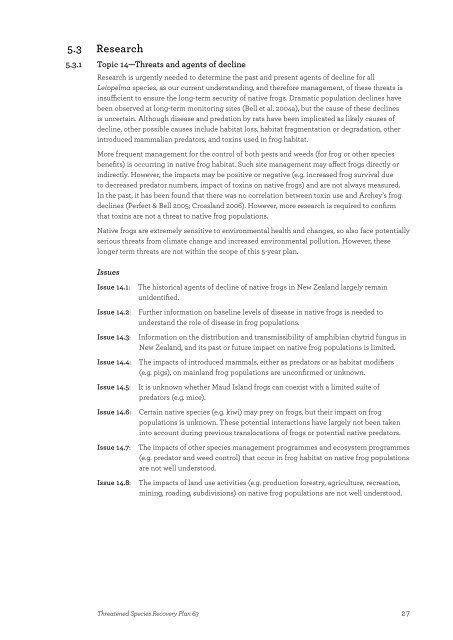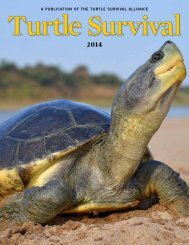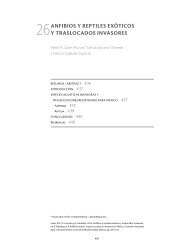tsrp63entire
tsrp63entire
tsrp63entire
Create successful ePaper yourself
Turn your PDF publications into a flip-book with our unique Google optimized e-Paper software.
5.3 Research<br />
5.3.1 Topic 14—Threats and agents of decline<br />
Research is urgently needed to determine the past and present agents of decline for all<br />
Leiopelma species, as our current understanding, and therefore management, of these threats is<br />
insufficient to ensure the long-term security of native frogs. Dramatic population declines have<br />
been observed at long-term monitoring sites (Bell et al. 2004a), but the cause of these declines<br />
is uncertain. Although disease and predation by rats have been implicated as likely causes of<br />
decline, other possible causes include habitat loss, habitat fragmentation or degradation, other<br />
introduced mammalian predators, and toxins used in frog habitat.<br />
More frequent management for the control of both pests and weeds (for frog or other species<br />
benefits) is occurring in native frog habitat. Such site management may affect frogs directly or<br />
indirectly. However, the impacts may be positive or negative (e.g. increased frog survival due<br />
to decreased predator numbers, impact of toxins on native frogs) and are not always measured.<br />
In the past, it has been found that there was no correlation between toxin use and Archey’s frog<br />
declines (Perfect & Bell 2005; Crossland 2006). However, more research is required to confirm<br />
that toxins are not a threat to native frog populations.<br />
Native frogs are extremely sensitive to environmental health and changes, so also face potentially<br />
serious threats from climate change and increased environmental pollution. However, these<br />
longer term threats are not within the scope of this 5-year plan.<br />
Issues<br />
Issue 14.1:<br />
Issue 14.2:<br />
Issue 14.3:<br />
Issue 14.4:<br />
Issue 14.5:<br />
Issue 14.6:<br />
Issue 14.7:<br />
Issue 14.8:<br />
The historical agents of decline of native frogs in New Zealand largely remain<br />
unidentified.<br />
Further information on baseline levels of disease in native frogs is needed to<br />
understand the role of disease in frog populations.<br />
Information on the distribution and transmissibility of amphibian chytrid fungus in<br />
New Zealand, and its past or future impact on native frog populations is limited.<br />
The impacts of introduced mammals, either as predators or as habitat modifiers<br />
(e.g. pigs), on mainland frog populations are unconfirmed or unknown.<br />
It is unknown whether Maud Island frogs can coexist with a limited suite of<br />
predators (e.g. mice).<br />
Certain native species (e.g. kiwi) may prey on frogs, but their impact on frog<br />
populations is unknown. These potential interactions have largely not been taken<br />
into account during previous translocations of frogs or potential native predators.<br />
The impacts of other species management programmes and ecosystem programmes<br />
(e.g. predator and weed control) that occur in frog habitat on native frog populations<br />
are not well understood.<br />
The impacts of land use activities (e.g. production forestry, agriculture, recreation,<br />
mining, roading, subdivisions) on native frog populations are not well understood.<br />
Threatened Species Recovery Plan 63<br />
27





